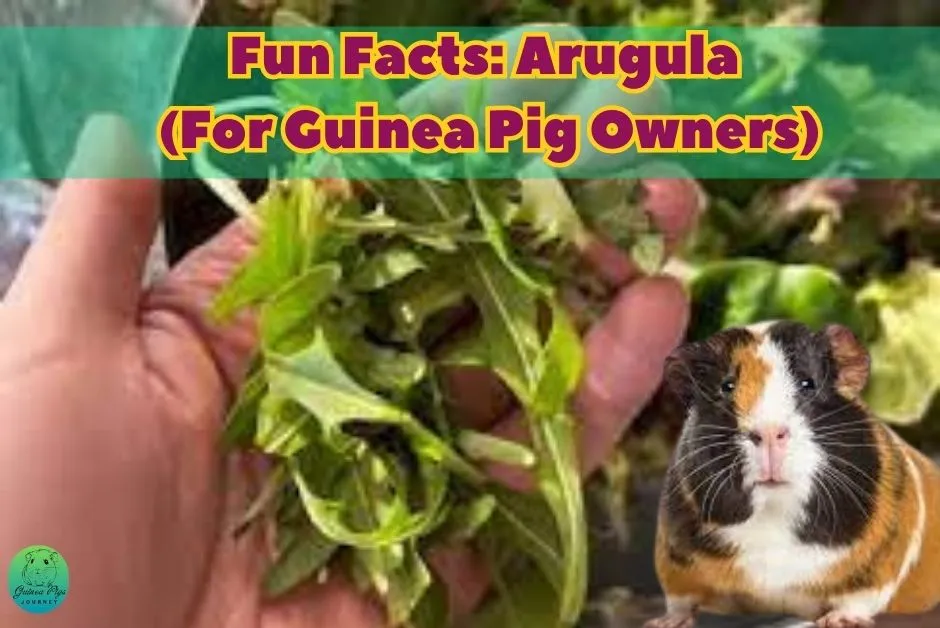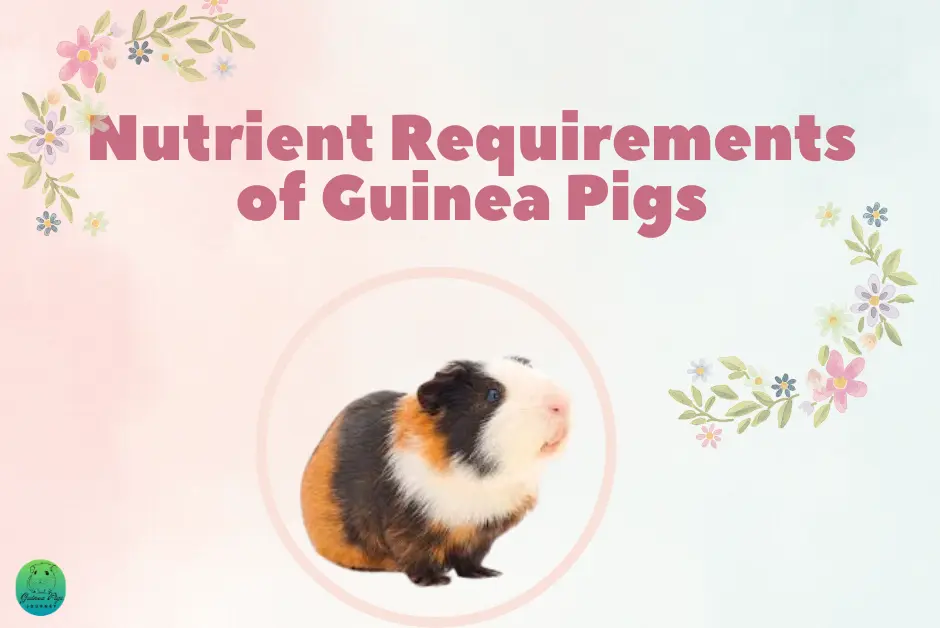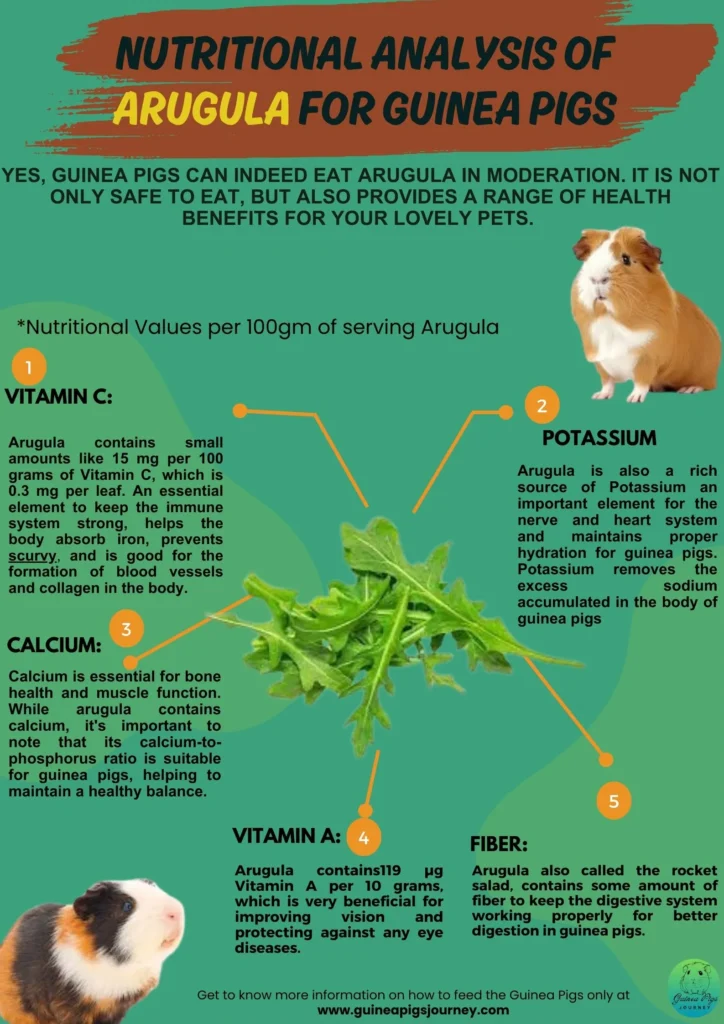Arugula, like Asparagus, Mustard greens, Cilantro, Zucchini, Snap Peas, lettuce, spinach, and kale is a leafy green vegetable. commonly consumed by humans as a part of their diet, that adds a distinct flavor in salads, sandwiches, wraps, pasta dishes, as a topping for pizzas, and various dishes and culinary preparations to enhance the overall taste and nutritional content of meal like a rich source of Vitamin C, minerals, Potassium, calcium, antioxidants, etc. But having a lovely pet and thinking about arugula to feed them is an important question that you must know;
Can Guinea Pigs Eat Arugula?
Yes, Guinea pigs can indeed eat arugula in moderation. It is not only safe to eat, but also provides a range of health benefits for your lovely pets. Arugula contains a packet rich with nutrients, minerals, flavors, and calcium which can be a problematic situation if this microgreen arugula is not fed in the right quantity to guinea pigs. Let’s have a look at several factors including risks and nutritional benefits related to arugula for guinea pigs.
Fun Facts: Arugula (For Guinea Pig Owners)
Arugula, whose scientific name is Eruca sativa belongs to the family Brassicaceae, the cabbage family which includes Brussels sprouts, broccoli, and kale. Its common names are ‘Salad Rocket’, ‘Garden Rocket’, ‘Eruca’ and ‘Rocket’, ‘Italian cress and first grown in the Mediterranean area of Roman times. It is a popular salad vegetable: its leaves, flowers, tender seed pods, and seeds are edible with moderation.

Arugula is a quick-growing plant as early as 40 days minimum and is annually grown for food purposes, Its leaves are highly pungent/flavored leaves with 4-10 small lateral lobes and a large terminal lob. Its flowers are up to 4 cm with white petals and yellow stems, arranged in corymb. Its fruit is a pod up to 4 cm long terminal beak containing many seeds. Arugula leaves have a peppery taste which becomes bitter as the plant ages. It grows up to a height of one meter under good growing conditions.
Growing Arugula in Kitchen Garden: Arugula is known as highly notorious, pepper-flavored dark green leaves used as salad vegetables and may be grown as annual herbs in the kitchen garden.
Climate and soil for growing Arugula: Arugula greens are ideal for healthy growth in cool and moist climates. However, plants are vulnerable to even mild frost hence frost protection is mandatory in that location where plants are susceptible. The most ideal soil is well-drained, rich fertile soil. The soil must be free from nematode moisture as the arugula plant is prone to nematode attack. Arugula is a sun-loving plant and requires plenty of sunlight for its leaf growth.
Propagation: Arugula propagation is via seeds. It may also be grown in a container which requires sown seeds at any time. However, for field growing, the spring season is the ideal time for seed sowing in well-prepared nursery beds which are mixed with decomposed organic matter.
Nutrient Requirements of Guinea Pigs:
Guinea pigs, natural and herbivore creatures consume large quantities of vegetation with their molar teeth well suited for grinding. Guinea pig’s diet consists of fresh, healthy, and high-quality Hay, vegetables, fruits, and occasionally pallets as a treat. Good, fresh, and clean drinking water is very necessary for their well-being and good health as well as nutritional requirements.

The Guinea pigs are best known from a nutritional standpoint, by their requirement for Vitamin C, a nutrient that is not self-produced by guinea pigs and relies on external sources. Vegetables are therefore considered rich in Vitamins, minerals, and other nutrients for many benefits.
This is why, along with other vegetables arugula for guinea pigs is also very important to consider to gain these nutrients and Vitamins beneficial for the overall health.
Nutritional Analysis of Arugula For Guinea Pigs:
According to the USDA Nutrient Database, Arugula for guinea pigs are excellent sources of minerals such as iron, calcium, and potassium as well as Vitamins like folic acid, Vitamin A, Vitamin K, and Vitamin C. It is better to first understand the value and composition of this vegetable; its nutritional information must be carefully examined. The key nutritional take-out per 100 grams of Raw, fresh Arugula for guinea pigs are as follows:
| Nutrients | Value per 100 grams |
| Energy | 25 kcal |
| Carbohydrates | 3.65 grams |
| Water | 91.7 grams |
| Fat | 0.66 grams |
| Protein | 2.58 grams |
| Dietary Fiber | 1.6 gram |
| Vitamin C, total ascorbic acid | 15 mg |
| Vitamin K | 109 µg |
| Vitamin A, RAE | 119 µg |
| Calories | 25 kcal |
| Cholesterol | 0 mg |
| Calcium, Ca | 160 mg |
| Phosphorus, P | 52 mg |
| Sugar | 2.05 grams |
| Potassium, K | 369 mg |
| Iron, Fe | 1.46 mg |
| Magnesium, Mg | 47 mg |
| Zinc, Zn | 0.47 mg |
| Sodium, Na | 27 mg |
| Ash | 1.4 grams |
| Copper, Cu | 0.076 mg |
Note: * The % Daily Value (DV) indicates how much a nutrient in a serving of food is subsidized to a daily diet.
The nutritional breakdown of Arugula arugula for guinea pigs has also good nutrients and vitamins as compared to some other vegetables, which is very crucial to explore one by one for a better understanding of guinea pigs.
One of the main components is water, which is safe and good on either side but also not much quantity is good for guinea pigs. Arugula for guinea pigs also contains high-quality calcium and its excess can often lead to bladder stones in guinea pigs. For a better understanding of such benefits and risk factors related to arugula, let’s delve into these nutrients one by one.
What Are The Nutritional Benefits of Arugula For Guinea Pigs?
Arugula arugula for guinea pigs can provide a nutrient boost and variety in their diet. However, like any food, moderation is very important.

Vitamin C Boost: Guinea pigs, much like humans, cannot produce their own vitamin C. Arugula for guinea pigs contains small amounts like 15 mg per 100 grams of Vitamin C, which is 0.3 mg per leaf. Guinea pigs require an average of 10-30 mg of Vitamin C daily for a healthy life. It is an essential element to keep the immune system strong, help the body absorb iron, and prevent scurvy and is good for the formation of blood vessels and collagen in the body. Vitamin C can also be increased through agronomic biofortification of arugula microgreens to increase micronutrients or minerals concentration to fulfill the Vit C requirements, thereby reducing the need for supplemental Vitamins.
Rich in Vitamin A: Arugula for guinea pigs contains 119 µg Vitamin A per 10 grams, which is very beneficial for improving vision and protecting against any eye diseases. However, to ensure the good functioning of some vital organs, Vitamin A also supports the immune system, reproduction, and cell growth and development in guinea pigs. It is also an important element for blood clotting and healthy bones and reduces osteoporosis risk. It also reduces the chances of coronary heart disease.
Vitamin K: Arugula for guinea pigs have also one of the common forms of Vitamin K (Vitamin K1 also called phylloquinone and phytonadione), which is important for blood clotting and appropriate bone metabolism.
Rich Source of Potassium: Arugula for guinea pigs is also a rich source of Potassium an important element for the nerve and heart system and maintains proper hydration for guinea pigs. Potassium removes the excess sodium accumulated in the body of guinea pigs.
Folate: Folate, or vitamin B9, is vital for cell division and DNA synthesis. Arugula for guinea pigs provides a portion of this important B vitamin.
Fiber: Arugula also called the rocket salad, contains some amount of fiber to keep the digestive system working properly for better digestion in guinea pigs.
High in Anti-Oxidants and Anti-Cancer Properties: Arugula for guinea pigs contains antioxidants, such as vitamin C and beta-carotene, which may help combat oxidative stress and support a healthy immune system. It has many cancer-fighting capabilities due to leafy green-rich antioxidants, which also protect against cell damage by targeting free radicals in the guinea body.
Calcium: Calcium is essential for bone health and muscle function. While arugula for guinea pigs contains calcium, it’s important to note that its calcium-to-phosphorus ratio is suitable for guinea pigs, helping to maintain a healthy balance.
Iron: Iron is essential for the formation of red blood cells (RBCs). While arugula for guinea pigs contains iron, it’s worth noting that guinea pigs absorb non-heme iron (found in plants) less efficiently.
Magnesium: Magnesium is involved in various physiological processes, including muscle and nerve function. Arugula for guinea pigs provides a small but beneficial amount of magnesium.
Scurvy Prevention: The high vitamin C content in arugula aids in preventing scurvy, a common health issue in guinea pigs due to their inability to produce vitamin C on their own.
Hydration Support: The water content in arugula contributes to hydration, especially when paired with fresh water. Proper hydration is essential for the overall health of guinea pigs.
Bone and Muscle Health: The calcium, potassium, and magnesium in arugula for guinea pigs contribute to bone health and support proper muscle function.
Arugula for guinea pigs has numerous benefits, but it should be fed in moderation as well. Excessive consumption can be dangerous and may lead to digestive issues such as diarrhea. To ensure a well-balanced diet you must consider a variety of veggies in guinea diets like Hay, palates, etc.
As with any dietary changes, it’s recommended to consult with a veterinarian to tailor the diet to the specific needs of your guinea pigs, especially if they have pre-existing health conditions or unique nutritional requirements.
What Are The Risks Of Feeding Arugula For Guinea Pigs?
Arugula for guinea pigs is a nutrient-dense food that needs an appropriate serving with moderation, if you being a good owner want to ensure the good health of guinea pigs, then you must consider eating patterns for guinea pigs. Here are some of the risk factors involved, if arugula is not fed to guinea pigs in moderation;

Bladder stone: Arugula for guinea pigs contains a good amount of Calcium i.e. 160 mg per 100 gm, which may lead to the formation of stones if fed in excess, so moderation is the key to avoiding such haphazard. Bladder stone is commonly diagnosed in guinea pigs due to excessive intake of calcium and oxalic acid and removed by a surgical process, which is painful for your lovely pets. It is suggested that, feed them arugula with great care and moderation to avoid any risk factor.
Digestive Upset: Arugula belonging to the cruciferous vegetable family have the chances of gassiness or stomach discomfort that may sometimes, if fed excessively cause diarrhea and bloating in guinea pigs due to their sensitive digestive system. Gradually offering the new food or serving limit can be very helpful in such cases to avoid any trigger to digestive upset in guinea pigs.
Pesticide Residues: Ensure arugula is carefully washed to remove any pesticide deposits that may harm your guinea pig’s digestive system also, and lead to diarrhea. Remember, always monitor your pets for any adverse reactions.
Allergic Reactions: Some guinea pigs may be allergic to certain foods, including arugula. Watch for signs of allergies, such as itching, skin reaction, or changes in behavior, when introducing new foods.
Calcium-Phosphorus Imbalance: While arugula contains calcium, it also has a good calcium-to-phosphorus ratio, making it generally safe for guinea pigs. However, an excessive intake of calcium-rich foods without a proper balance of phosphorus can lead to health issues. Ensure a diverse diet to maintain the right balance.
Kidney Stones: While arugula is relatively low in oxalates compared to some other greens, it still contains them. High oxalate levels in the diet can contribute to the formation of kidney stones in guinea pigs. Moderation is key to minimizing this risk.
Excess Vitamin A consumption can be problematic: Arugula rich in Vitamin A, if not fed in moderation may lead to liver problems, nausea, blurred vision, muscle aches, and potential issues with brain and bones.
How to Prepare Arugula for Guinea Pigs?
Before offering Arugula, being a caring owner, it is very important to take some responsible steps to make it a beneficial and happy treat for your furry friends to ensure safety and remove pesticides and chemicals sprayed during harvesting. Here are some key steps to consider while preparing Arugula for guinea pigs:

Step-1: Purchase / Choose good quality: Always buy some fresh, green, and healthy leaves from a verified store or verified dealer, ensure that leaves are not spoiled, rotting, or overly wilted so that you can have some good quality and fresh arugula for your guinea pigs.
Step 2: Wash and dry the Arugula microgreen leaves: Thoroughly wash and clean the leaves in running water to remove the chemicals, pesticides, or traces of germs. After washing let them dry properly before offering.
Step-3: Stem and Stalk Removal (Optional): You may also remove or cut the stalks and stems, but it is optional.
Step-4: Slice Arugula leaves into small pieces (Optional): It is optional as a treat, that arugula leaves after washing properly, you may slice them into small chewable size pieces to avoid choking issues. But if you serve arugula leaves without slicing, there is no harm in it, as Guinea can eat the whole plant but observe first if your guinea pig likes it or not.
Step-5: Introduce in appropriate quantity: You must feed arugula leaves to your guinea pigs gradually and in small pieces and observe any reaction or sign before serving more or frequency of feeding. So that any kind of reaction may be avoided.
Step-5: Treat / Serve Arugula: You may also give Arugula salad to your guinea pigs as a treat like feeding it with your hands or holding a guinea pig on a lap. It is recommended, that use the arugula leaves within 3 days to keep them fresh for guinea pigs. Only wash the arugula before feeding them to guinea pigs to keep them tasty and avoid the wilt factor.
How Often Can Guinea Pigs Eat Arugula?
It is best to feed only 2-3 leaves once or twice a week due to their high calcium content and to ensure moderation and proper observing and monitoring are mandatory while feeding.

If offering baby arugula leaves, then a half dozen leaves may be enough per serving. Avoid feeding any arugula salad, pasta mixed, or pizza topping arugula to guinea pigs to avoid any digestive issues.
Feeding arugula with some low-calcium foods like blackberries, grapefruits, mushrooms, cucumber, bell peppers, radicchio, and blueberries to ensure too much consumption of calcium all at once.
Can Baby Guinea Pigs (Pups) Eat Arugula?
Arugula, a delicious and healthy leafy vegetable is also good for baby guinea pigs (Pups) for its nutritious qualities if served in moderation. The calcium is also good for baby guinea pigs to store it and prevent scurvy and other health issues.

Baby Guinea pigs also require Vitamin K for bone development and brain growth. Baby guinea pigs can also enjoy arugula leaves to take a good amount of vitamin C important for them.
Introducing gradually is the key to new baby guinea pigs, to avoid any kind of risk factor. As young Guinea pigs’ digestive system is sensitive, baby guinea pigs also need care in this aspect to feed any new food. Slowly and gradually offering with moderation is the key to making it a better option for baby guinea pigs (Pups).
Can Guinea Pigs Eat Arugula Sprouts?

Arugula sprouts, also called arugula microgreens are good to go with the moderation principle while feeding your guinea pigs. These microgreens are also rich in nutrients, Vitamins, and minerals like other counterparts. Microgreens are milder in taste and fully delicious like baby arugula leaves. Microgreens are easy to grow in kitchen gardens and pots. You may try to sow some seeds of microgreens in your kitchen garden for guinea pigs to be easily available within 10 days of fast-growing and fresh leaves grown by yourself.
Can Guinea Pigs Eat Arugula Stems?
Yes, with proper monitoring and moderation, you can feed your guinea pigs arugula stems, but experts recommend that feed stems with leaves. However, observe them while eating stems, as it has been observed that some cavies do not like stems’ flavor.

Can Guinea Pigs Eat Arugula Stalks?
Yes, prepare arugula stalks with arugula leaves to make it a treat to enjoy with guinea pigs. However, always limit the arugula stalks while feeding to prevent any digestive issues like diarrhea or stomach upset.
Can Guinea Pigs Eat Arugula Vines?
Yes, feeding arugula vines is not harmful just like other parts as long as they are fed in moderation and with proper care to guinea pigs, you may also mix arugula vines with arugula leaves and other green leafy veggies in small quantities.
Can Guinea Pigs Eat Arugula Roots?
Yes, you may feed your guinea pigs arugula roots of rocket salad with arugula leaves and green stalks mixed in it. It is perfectly healthy and nutritious for them.
Can Guinea Pigs Eat Arugula Flowers?
Yes, Arugula flowers are safe to feed guinea pigs in small quantities and in moderation to ensure the proper intake of nutrients for your furry friends. The high amount of calcium and other enzymes present in arugula flowers may disturb or lead to digestive issues in guinea pigs if fed in excess quantity.
Can Guinea Pigs Eat Arugula Seeds?
Although, there is no harm in eating seeds, avoid feeding Arugula seeds to Guinea pigs even if arugula seeds are safe to eat to avoid any kind of digestive issues like diarrhea, stomach upset, or gastrointestinal upset.
It may also lead to choking and cause dental or gum-related issues in cavies, due to the small teeth of guinea pigs.
Can Guinea Pigs Eat Cooked or Processed Arugula?
No, it is suggested that, avoid feeding any type of cooked, processed, or salted arugula like addition in Pasta, Pizza topping, Arugula bread crumbs, basil pesto consisting of cheese or avoid any kind of oil and other ingredients and spices, which may be harmful for guinea pigs causing digestive problems. Cooking may remove the nutrients and make it harder or wilted to digest guinea.
Foods Alternate to Arugula For Guinea Pigs:

There are plenty of other alternatives if your guinea pig is not crazy about arugula to eat. Just like Arugula, these foods also provide nutrient-rich elements but different in quantity that can boost health in many ways of your Guinea pigs. Here are some good alternatives or veggies to consider when preparing a salad in moderation for your cavies;
| Asparagus, raw | Rutabagas, raw | Brussel Sprouts | Mustard Greens |
| Endive, raw | Spinach, raw | Wheatgrass | Cucumber |
| Kale, raw | Beetroot (occasionally) | Lettuce (exclude iceberg lettuce) | Red and Green Bell Peppers |
| Kohlrabi, raw | Arrowroot, raw | Butternut Squash | Broccoli rabe |
| Pumpkin, raw | Tomatillos, raw | Zucchini | Green Beans |
| Carrots | Cauliflower | Corn | Peas |
| Artichokes | Radicchio, raw | Oregano | Thyme |
| Parsnips | Turnips | Cilantro | fennel |
KEY TAKE-OUTS:
- Arugula for guinea pigs, is a leafy green veggie rich in nutrients, Vitamins A, K, and C, minerals, and a very delicious rocket salad.
- Always feed any new food like arugula in moderation, to ensure the safety and care of guinea pigs.
- Limit the serving up to 1-2 servings a week or twice for better health.
- Serve only a small and fresh leaf of arugula at a time to cavy.
- Always remember, do not replace the hay with any other alternatives in the guinea diet.
- Remove the left-out or uneaten part of any food from the guinea pig cage to avoid the multiplication of germs bacteria and flies for the well-being and good care of your lovely pet.
- Do remember, in case of any hazardous situation, just give a call or check-up for your guinea pig to a veterinarian for further guidance.







